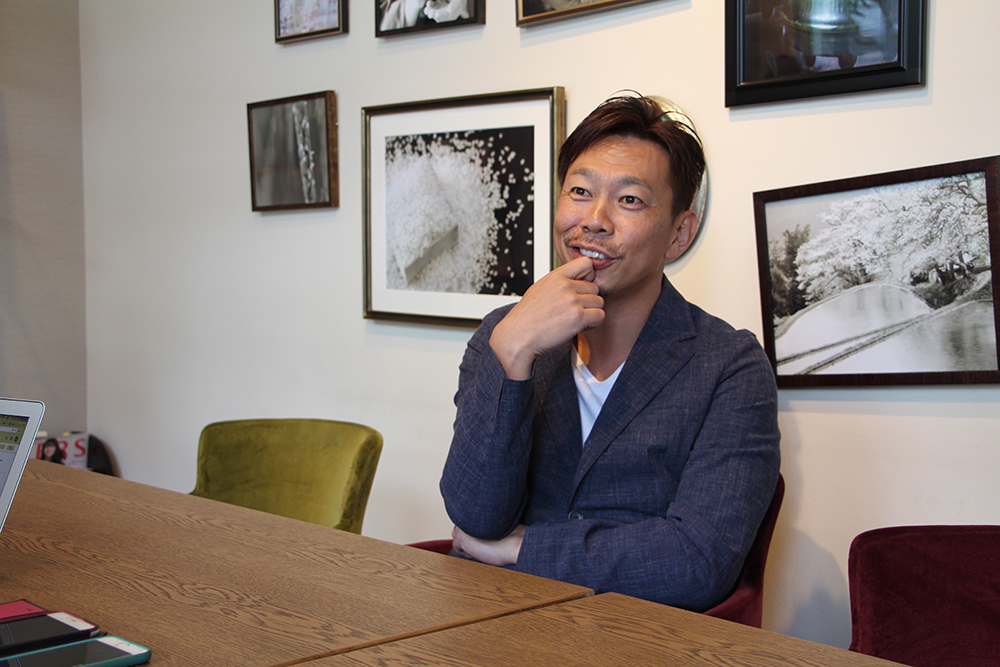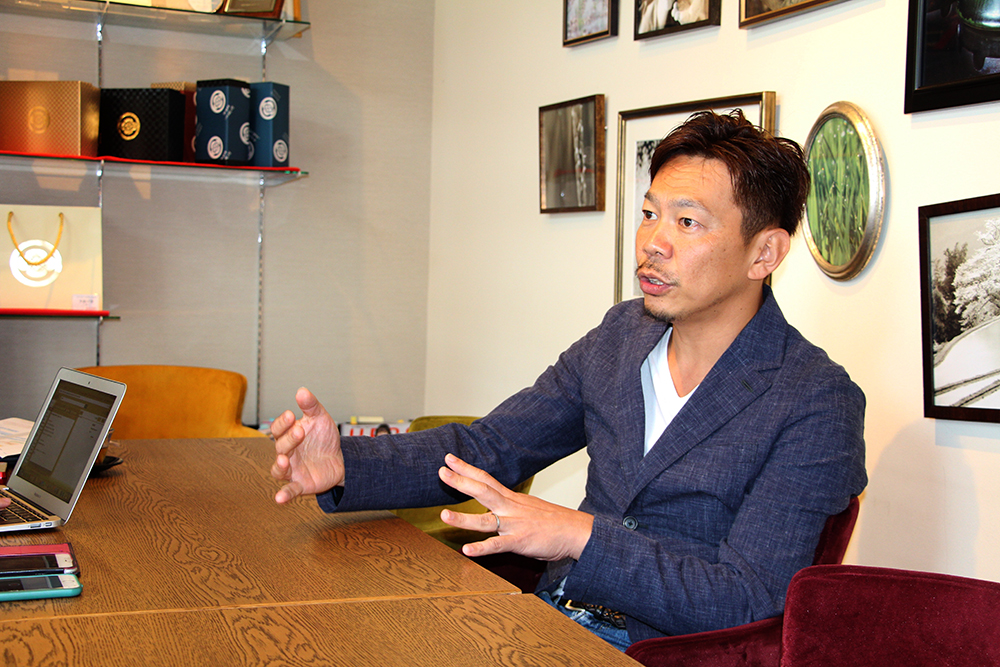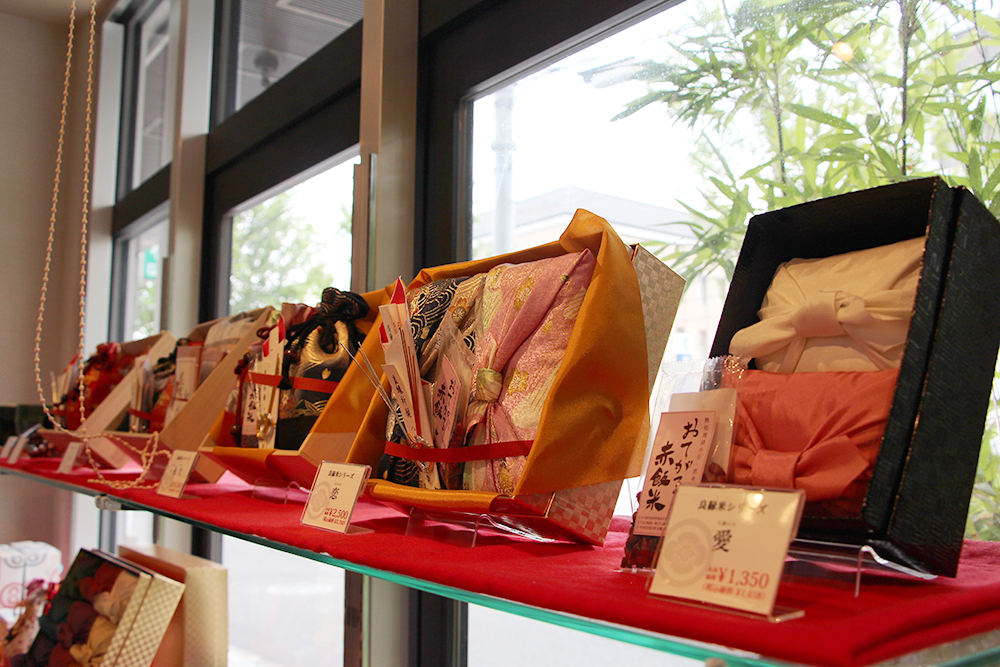
Omotenashi (Japanese hospitality) and okome (rice) are two examples of Japan’s many contributions to the world.
What better person to discuss these topics with than Mr. Takashi Hashimoto, President and CEO of Hachidaime Gihey—a company dedicated to sharing the highest quality rice in Japan with as many people as possible.
---I wanted to talk to you about how Hachidaime Gihey and its products have developed in the context of your Rakuten shop and E-Commerce business. Before we delve into that subject, however, could you tell us what kind of hurdles you encountered when you started out?
First of all, you have to ask yourself, “What do I want to do?” You also have to know what your strengths are. Simply knowing those strengths, however, isn’t enough, because you may not be aware that there’s someone else, say in a neighbouring prefecture, who can do that thing much better than you can.
I’ve been doing this for a long time, always with the belief that I would be the best in Japan. So, from the day I took over the family business, I made the decision that I wouldn’t simply sell rice—my job was to deliver delicious rice. Only by doing that could I become number one in Japan. From there, it was just a matter of how.
Unfortunately, there wasn’t anyone else around me who thought like that, so I didn’t have anyone to confide in. On top of that, even though I had been able to create a market for “rice gifts,” I wasn’t sure how to follow-up in the event that the idea really took off. I also wasn’t sure that what I was doing would really resonate with the rest of the world. I later realized that, in the face of those questions, had I not held my strong convictions while working toward the next developments in my business, I likely would never have made it past that first phase.
---Is what you’re seeing now different than from what you were seeing at the beginning?
The scenery is always the same. It’s how much of it you are seeing that’s different. If you’re going to sell products online, you can’t just divide up the work between people and hope for the best—you have to think of everything, from product planning to copywriting. That might be the most important thing. If you divide the work up from the start, your ideas are going to be conveyed differently by every person that is tasked with interpreting them, and they may end up completely different than what you had originally intended. When it comes to the internet, you have to carefully monitor everything, from upstream to downstream. The real question is, are you able to take on that risk?
---Was there any point in particular that made you realize you were able to take on such a risk?
Not really. I just knew there was no going back. I think if you’re not willing to take on risks, it just means you’re not ready. Sales is by no means easy, so if you are going to take your business online, you have to be ready to take on all of the responsibility yourself. If at that point you’re thinking, “There’s no way I can do this. I’ll ask someone else to do it instead,” you’re in trouble. In fact, the only thing I’ve ever outsourced was the creation of our website. While Miyata-san was creating our site, I didn’t hesitate to let him know exactly what I wanted from a design standpoint. At the beginning, he’d often say “Mr. Takahashi, can you at least let me finish one pass at the site before you start blasting every single aspect of the design?” (laughs) Building a homepage is a lot different than drawing a picture. You really have to go into a lot of detail, building bit after bit. That’s why [Miyata-san] was so upset. (laughs)
---Sounds like you gave the web designers a run for their money. (laughs)
Yup. But it was my first foray into the online portion of the business, so it gave me an opportunity to reexamine my convictions. In the beginning, we were re-doing the homepage once every half a year, because I thought that the design of the page was going to sell products. I also believed that I had to revise other aspects like SEO, and customer satisfaction.

---Did these experiences remind you of how difficult it is to sell products online?
It’s pretty scary stuff. Now we’ve moved our focus to smartphones, but there’s always this question of how long the trend will last. Once the new big device comes out, our existing methods will instantly become outdated, right?
The big question, then, is when consumers find a new product to consume, how well will companies be able to keep up? That’s why, even though people often praise us for succeeding with the e-commerce part of our business, we are always investing more than we need to. Those that don’t understand why it’s necessary to do so probably won’t go very far in business.
---Interesting. Which phase would you say Hachidaime Gihey is currently in?
Maybe in between our third and fourth phase? I guess you could call this a period of maturity. We have already crossed the chasm (before really making it into the mainstream) between phases one and two. I really learned a lot during that time.
From here, I think it’s up to the managers to turn the gears. As one of them, I should be making all the decisions directly, right? Well, it’s not that simple, both because it’s physically and emotionally exhausting, and because my employees are going to start wondering where their decision-making authority really lies if I’m the one making all the final decisions. If they can’t make decisions on their own, they can’t grow. Nonetheless, it’s hard for me because I always know what I want to say, but I can’t always say it.
---That’s tough. Because the people on the other end are probably saying “Hurry up and say something!”
Exactly. Especially when you’ve asked an employee to tell the client something, and then you have to go back and tell the client that you’re going to do something else instead. But if someone makes a mistake, it could seriously impact the company—so sometimes that kind of response is necessary. If it turns out my employee’s decision was actually the right one, though, I have no choice but to apologize.
You have to teach your employees to think things through. If you don’t, your company won’t grow. I am confident that I can get a lot done on my own; but, as the business grows, this gets more and more difficult to do. It’s really important for your employees to be able to react appropriately if you want things to go smoothly. It can get pretty nerve wracking when you have to entrust someone else with certain responsibilities, because the result is going to depend solely on their will. But you just have to respect that.
---What have you experienced the most trouble with during each of your phases? And how did you overcome those issues?
The most difficult part of our first phase was creating a framework. We got our website going, but we didn’t have any stock, and we only had 5 employees—including part time staff. It was like the workplace was my house; and my office was the kitchen. That went on for two years.
As we started to get more business, I began to leave the part time employees in charge of wrapping the rice in furoshiki (Japanese wrapping cloth). At a certain point, however, we hit a wall: one person would be able to wrap 50 gifts a day; and two people were able to wrap 100. However, once I hit three people, that number only went up to 130—160 with four people, and then only 170 with five. It became readily apparent to me that relying on a simple calculation of 1 person, 50 packages, wasn’t realistic. We had reached capacity.
We were faced with the following situation: if we hired more part time staff, we would need to hire more full time staff to manage them. On top of that, the amount of products being packaged wasn’t proportional to the number of part time staff we were hiring. Our questioning of whether it was feasible to try to tackle this issue on our own signaled the beginning of our second phase.
When sales increase, you need more people to respond. We had labourers, but because our standards were so high, we were having a hard time finding new people. At one point, we had 100 candidates apply, and we didn’t hire any of them.
If you’re hiring for something like an IT role in Tokyo or Osaka, you’ll have tons of highly qualified candidates knocking down your door—assuming the price is right, of course. But in Kyoto, it’s a different story. Phase two was dictated by that struggle.
---I definitely can relate with regard to part about hiring in Kyoto, although probably not on the same scale as you’ve experienced.
It’s tough, right? (laughing)
---There’s something about Kyoto. People from Kyoto don’t typically go to companies who search for candidates in both Osaka and Kyoto. Neither do people from Osaka. It’s almost like people only start coming when you begin searching exclusively in Kyoto.
It’s really been difficult. Even the Kyoto-born people we hire, the only reason they are with us is because they stuck around in Kyoto after university. We also have the occasional person who quits the JA (Japan Agricultural Cooperatives) because they want to do rice-related work. Hiring has been our biggest challenge.
---Phase One: Framework. Phase Two: People. It seems like both of those pieces are connected to Hachidaime Gihey’s renowned customer service and support operations...
Absolutely.
---You put a lot of effort into customer service. Even for the site renewal, you had someone from your company in charge of the customer service aspect. Could you please share some of your thoughts on the topic.
The internet is a battlefield where companies vie to attract customers by attepting to set themselves apart from one another. We felt that the customer angle was the best approach to take in order to stand out from the crowd.
Even if we’re not able engage in face-to-face transactions with clients, we’re still a company that specializes in gifts. If we fail to respond to even one letter of thanks from a customer, they’re going to think, “This is a company that only cares about selling gifts. They don’t really know anything about Kyoto,” or “What terrible manners!” In my opinion, that’s the worst response a company can get from its customers.
If a customer comes up to me and says, “You’re just disguising your rice as gifts to boost sales,” I have to be able to tell that customer that they’re simply mistaken. More importantly, in order to do really make our customers feel appreciated and earn their trust—in order to show that we’re different from companies who are just looking to make a profit by disguising their products as gifts—words simply aren’t enough. We need to act accordingly.
Here’s one example: there was a point when the SEO rules changed, and we were penalized by Google, causing our site to no longer appear in search results. Even in those circumstances, our sales didn’t really drop. I realized then that it’s not SEO alone that sells products, its having a brand that stands on its own. In a way, going digital has encouraged us to nurture the analogue side of our business even more.

---How many people were working at the company when you decided to establish a separate Customer Service department?
Just two part time employees.
---In other words, there was already a Customer Service department during the period you discussed where you only had five employees?
That’s right. I’ve always felt strongly about what I like to refer to as a “one-to-one” method of operation. What I mean by this is, because everyone thinks differently, ten people will select ten different products. Therefore, you need ten people to provide ten different types of customer support. I felt this way 20 years ago, and I still do today. That’s why, when Hachidaime Gihey was first established, it was able to provide good customer service: because it looked after each customer, one by one.
---A little while back in the restaurant industry, there seemed to be a trend where the primary, secondary, and tertiary industries kind of combined to creath a sixth industry. In that sense, are you interested in monitoring every aspect, both up and downstream, on your own?
I think so. I want to tackle every aspect from every direction. I think that’s just part of who I am.
This is an extreme example, but consider the case where our business was growing so rapidly that we decided to outsource our customer service operations to a call center. I thought about doing this many times, but every time I did, I ended up abandoning the idea because I reminded myself that it would be expensive, and that there aren’t many companies like this in Kyoto. There just are some things that you can’t give up.
---It can be scary when the type and scale of one’s business changes. Bearing that in mind, what developments are you planning going forward.
I want to leverage the media to ensure people recognize Hachidaime Gihey as an e-commerce business. If I can do that, I think the company’s mission will live on even if devices change.
---I think it’s your personality—the way you take control of the branding yourself, your producer-like nature when it comes to all things related to rice, and the way you’ve maintained these qualities—that make you almost something of an evangelist. I’m sure that’s the reason Hachidaime Gihey has lasted as long as it has.
Maybe. The customers probably think of me the same way. That’s why I freak out when customers leave feedback like, “We look forward to seeing what new products Hachidaime Gihey has in store.” Aren’t gifts of rice enough!? (laughs)
---When you get comments like that, you can’t help but feel the need to step up to the plate.
Exactly. I feel like I have been given a mission. It’s my mission, as the “Hachidaime” (eighth generation) in Hachidaime Gihey, to keep things moving forward.


▲Hachidaime Gihey’s Juuni Hitoe—winner of the gold medal at OMOTENASHI SELECTION 2014—is a popular gift among celebrities and purveyors to the Imperial Household.